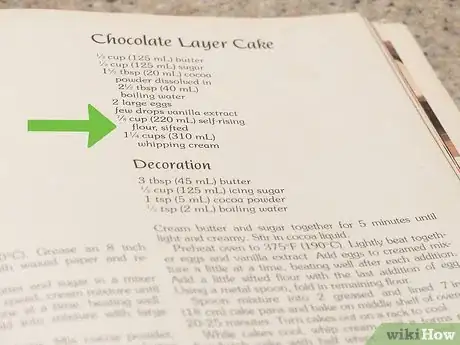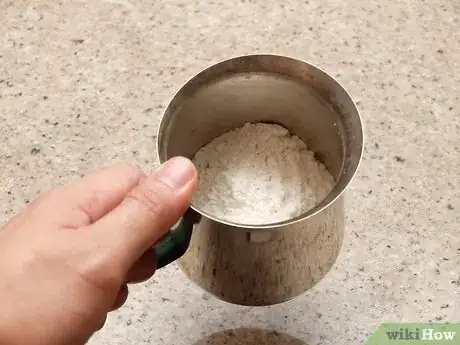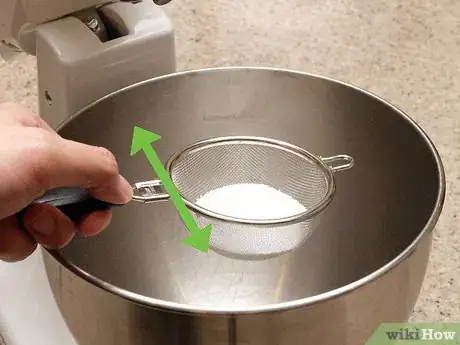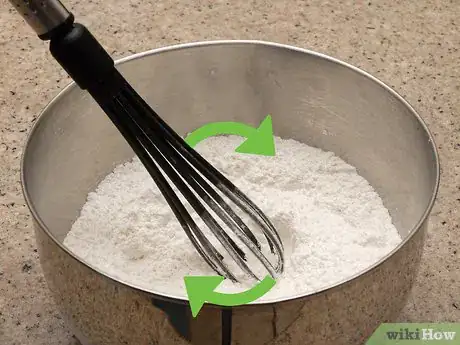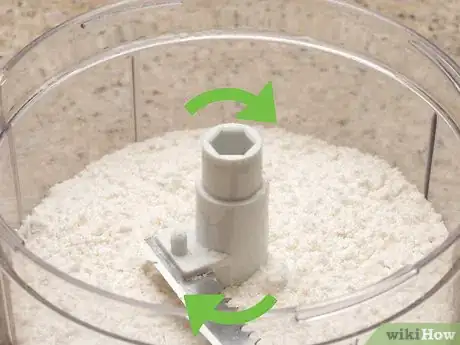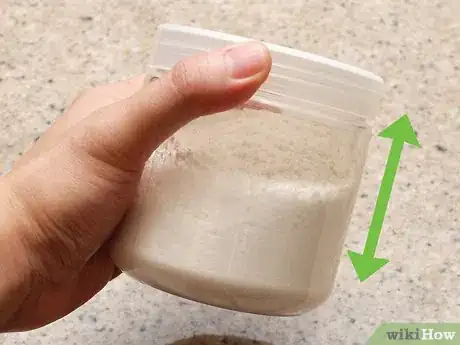This article was co-authored by Jessica Banh. Jessica Banh is a Pastry Chef and the Owner of Fancy Flavors in San Jose, California. With over 12 years of technical experience, Jessica has expertise in a wide variety of pastry techniques and has a focus on macarons. Her work has been featured in The SF Chronicle, The Mercury News, and Good Morning America. She received her training from The Professional Culinary Institute.
This article has been viewed 253,007 times.
Sifting incorporates air into the flour, which helps your baked goods to come out light and fluffy.[1] This is important as store-bought flour is usually tightly packed, and may have been crushed even further during shipping and storage. Sifting helps to remove any lumps from the flour (which could affect your baking) and also removes any unwanted debris. In addition, sifting helps to combine the flour with any dry ingredients like baking powder, salt or cocoa powder before they are added to the recipe. There are several different ways you can sift flour - but whichever method you choose, your baking will surely be all the more delicious! Start with Step 1 below to learn the hows and whys of sifting flour.
Steps
-
1Take note of the wording in your recipe. One important item to address before you start is the wording in your recipe with regards to sifting.
- Sometimes the recipe will call for "1 cup of flour, sifted". When this is the case, you can simply scoop 1 cup of flour out of the bag and sift it afterwards.
- However, some recipes call for "1 cup of sifted flour". In this instance, you need to sift the flour before you measure it. You can do this by scooping 1 cup of flour from the bag and sifting it into a bowl. Then use a tablespoon to transfer the sifted flour back into the measuring cup, using a knife to even the top.
-
2Use a sifter.
- Place the flour into the sifter and hold the sifter over the mixing bowl. The higher you hold the sifter, the more air you will incorporate into the mixture.
- However, holding the sifter high over the bowl can make a mess, so it's a good idea to place a sheet of waxed paper under the bowl to catch any errant flour. Then it can easily be scooped up and added to the bowl.
- Sift the flour by shaking or squeezing the sifter - the flour will fall lightly into the bowl below. If your flour is particularly lumpy, or you need it extra light and fluffy for a certain recipe (such as angel food cake) you can sift it a second time.[2]
- If you want to combine the flour with other dry ingredients like baking or cocoa powder, simply place all of the ingredients into the sifter at once and sift as normal.
Advertisement -
3Use a sieve or colander. If you don't have a sifter, you can easily use a fine-meshed strainer to do the job.
- Simply put the flour into the strainer and tap the side or use a fork to sift the flour through.
- If you don't have a fine-meshed strainer, a regular strainer or even a colander will do.
-
4Use a whisk. You can also use a wire whisk to mix the flour in a bowl. Although this won't get the flour as light and fluffy as using a sifter, it will help to break up any lumps and incorporate a little air into the flour.
- Whisking also allows you to kill two birds with one stone - you can mix all of your dry ingredients together as you aerate the flour.
-
5Use a food processor. A food processor will achieve the same results as a whisk - only faster. Place the flour in the food processor and pulse four or five times. Just make sure the lid is on securely - otherwise you'll end up with flour everywhere!
-
6Store your flour in a plastic container. When you store your flour in the bag you purchased it in, it can easily become compressed and devoid of air.
- Therefore, it is a good idea to transfer the flour to a large, airtight storage container as soon as you get home from the grocery store.
- Once the flour is in the storage container, give it a stir with a fork or wooden spoon to incorporate some air. Alternatively, you can just give it a good shake with the lid on!
- Then the next time you need flour in a recipe, you can just give the flour in the container another good stir before using.[3]
Expert Q&A
-
QuestionWhen should you sift flour when baking?
 Jessica BanhJessica Banh is a Pastry Chef and the Owner of Fancy Flavors in San Jose, California. With over 12 years of technical experience, Jessica has expertise in a wide variety of pastry techniques and has a focus on macarons. Her work has been featured in The SF Chronicle, The Mercury News, and Good Morning America. She received her training from The Professional Culinary Institute.
Jessica BanhJessica Banh is a Pastry Chef and the Owner of Fancy Flavors in San Jose, California. With over 12 years of technical experience, Jessica has expertise in a wide variety of pastry techniques and has a focus on macarons. Her work has been featured in The SF Chronicle, The Mercury News, and Good Morning America. She received her training from The Professional Culinary Institute.
Pastry Chef Sift flour for baked goods that are a little lighter and fluffier, like cakes—you don't necessarily need to sift for recipes like cookies. Still, it's always a good idea to sift any dry ingredients that are looking lumpy so they'll be nice and fine when you use them in your recipe.
Sift flour for baked goods that are a little lighter and fluffier, like cakes—you don't necessarily need to sift for recipes like cookies. Still, it's always a good idea to sift any dry ingredients that are looking lumpy so they'll be nice and fine when you use them in your recipe. -
QuestionShould I sift the flour when I am making a yeast bread?
 Community AnswerYes, to make sure there aren't any non-flour items in the flour, and make sure the flour is fine.
Community AnswerYes, to make sure there aren't any non-flour items in the flour, and make sure the flour is fine. -
QuestionCan I use any kind of flour?
 Community AnswerDifferent recipes require different types of flour. Check your recipe to see what kind of flour to use.
Community AnswerDifferent recipes require different types of flour. Check your recipe to see what kind of flour to use.
Things You'll Need
- Flour
- Flour sifter/sieve
- Spoon
- Bowl
- Measuring cup
- Waxed paper
References
- ↑ Jessica Banh. Pastry Chef. Expert Interview. 6 April 2022.
- ↑ Jessica Banh. Pastry Chef. Expert Interview. 6 April 2022.
- ↑ http://joythebaker.com/2013/09/baking-101-must-we-sift-this-flour/
About This Article
The easiest way to sift flour is using a sifter. However, if you don't have a sifter, you can still sift flour by putting it into a sieve or colander and then shaking it over a bowl. You can also whisk the flour in a bowl, which will help break up any clumps like a sifter does. If you have a food processor, you can pour the flour into that and then turn it on to sift it. Whichever method you use, you may need to sift your flour multiple times if it's extra dense and clumpy. If you want to learn how to store your sifted flour, keep reading the article!

